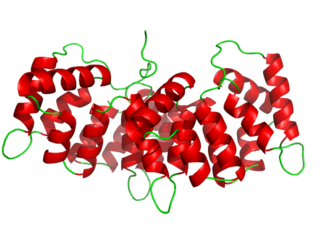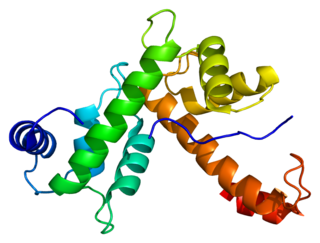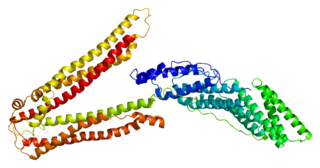
Annexin is a common name for a group of cellular proteins. They are mostly found in eukaryotic organisms.

Annexin A2 also known as annexin II is a protein that in humans is encoded by the ANXA2 gene.

Annexin A5 is a cellular protein in the annexin group. In flow cytometry, annexin V is commonly used to detect apoptotic cells by its ability to bind to phosphatidylserine, a marker of apoptosis when it is on the outer leaflet of the plasma membrane. The function of the protein is unknown; however, annexin A5 has been proposed to play a role in the inhibition of blood coagulation by competing for phosphatidylserine binding sites with prothrombin and also to inhibit the activity of phospholipase A1. These properties have been found by in vitro experiments.

FBLN1 is the gene encoding fibulin-1, an extracellular matrix and plasma protein.

Annexin A6 is a protein that in humans is encoded by the ANXA6 gene.

Programmed cell death protein 6 is a protein that in humans is encoded by the PDCD6 gene.

Glycylpeptide N-tetradecanoyltransferase 1 also known as myristoyl-CoA:protein N-myristoyltransferase 1 (NMT-1) is an enzyme that in humans is encoded by the NMT1 gene. It belongs to the protein N-terminal methyltransferase and glycylpeptide N-tetradecanoyltransferase family of enzymes.

Calpastatin is a protein that in humans is encoded by the CAST gene.

Programmed cell death 6-interacting protein also known as ALIX is a protein that in humans is encoded by the PDCD6IP gene.

S100 calcium-binding protein A6 (S100A6) is a protein that in humans is encoded by the S100A6 gene.

S100 calcium-binding protein A11 (S100A11) is a protein that in humans is encoded by the S100A11 gene.

Telethonin, also known as Tcap, is a protein that in humans is encoded by the TCAP gene. Telethonin is expressed in cardiac and skeletal muscle at Z-discs and functions to regulate sarcomere assembly, T-tubule function and apoptosis. Telethonin has been implicated in several diseases, including limb-girdle muscular dystrophy, hypertrophic cardiomyopathy, dilated cardiomyopathy and idiopathic cardiomyopathy.

Annexin A4 is a protein that in humans is encoded by the ANXA4 gene.

Sorcin is a protein that in humans is encoded by the SRI gene.

Annexin A7 is a protein that in humans is encoded by the ANXA7 gene.

Annexin A3 is a protein that in humans is encoded by the ANXA3 gene.

Alpha-1,3/1,6-mannosyltransferase ALG2 is an enzyme that is encoded by the ALG2 gene. Mutations in the human gene are associated with congenital defects in glycosylation The protein encoded by the ALG2 gene belongs to two classes of enzymes: GDP-Man:Man1GlcNAc2-PP-dolichol alpha-1,3-mannosyltransferase and GDP-Man:Man2GlcNAc2-PP-dolichol alpha-1,6-mannosyltransferase.

Peflin is a protein that in humans is encoded by the PEF1 gene.

Annexin A13 is a protein that in humans is encoded by the ANXA13 gene.

Annexin A9 is a protein that in humans is encoded by the ANXA9 gene.
























